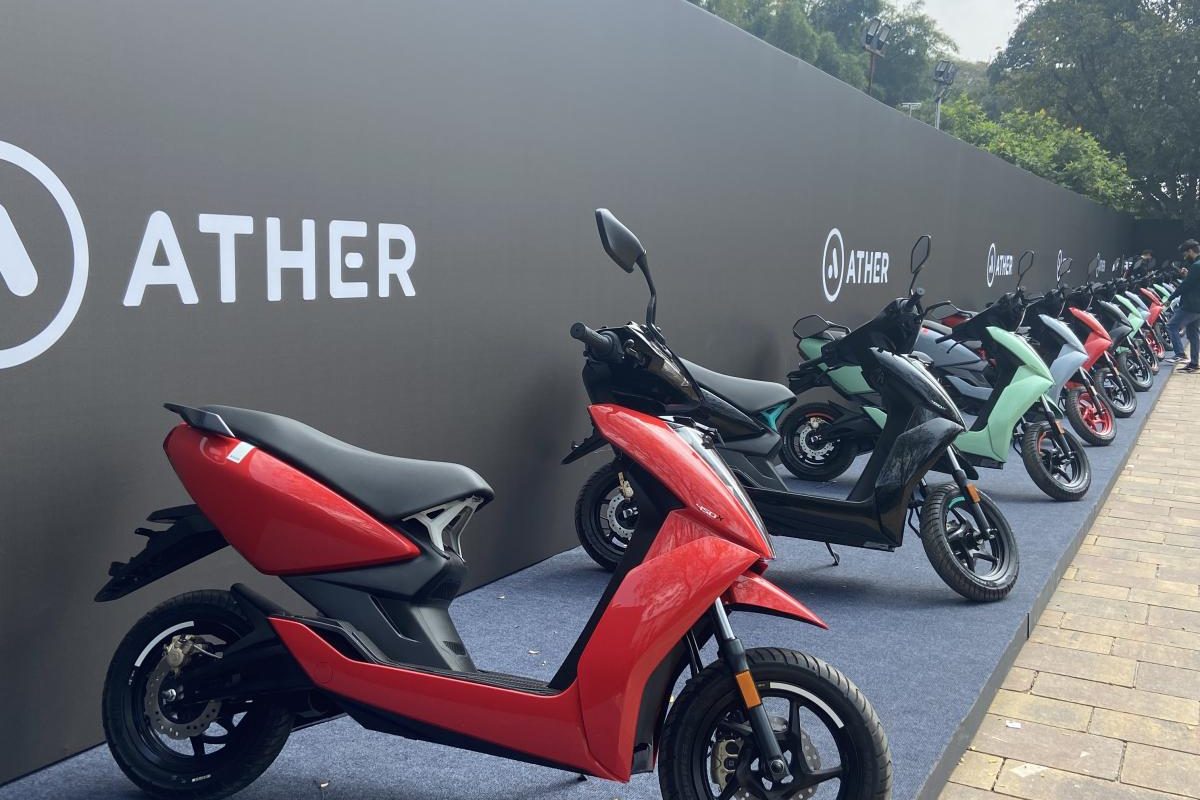About the Company:
Ather Energy Limited is a dedicated electric vehicle (EV) manufacturer, focusing exclusively on electric two-wheelers (E2Ws) and an integrated product ecosystem including proprietary software, charging infrastructure, and smart accessories. The company was founded by Tarun Sanjay Mehta and Swapnil Babanlal Jain in 2013, and later Hero MotoCorp Limited joined as promoter in 2016 through a Series B round of funding. Ather Energy became a unicorn, reaching a valuation of $1.3 billion, in August 2024 after securing $71 million (approximately ₹600 crore) in funding from the National Investment and Infrastructure Fund.
It has sold 1,07,983 and 1,09,577 units E2Ws in the nine months ended December 31, 2024 and Fiscal Year 2024, respectively. It commanded an E2W retail market share of 10.7% and 11.5%, respectively.
The company’s E2W lineup consists of two main product lines—the Ather 450, launched in June 2018, catering to customers seeking performance scooters, and the Ather Rizta, launched in April 2024, targeting customers seeking convenience scooters for their family. It offers EVs in a total of seven variants, which are strategically positioned in the premium segment of the electric two-wheeler market.
Battery packs are manufactured by the company in-house using lithium-ion cells sourced from suppliers. Portable chargers and motors are procured from suppliers who handle designing and manufacturing. Other vehicle components such as chassis, motor controllers, transmissions are designed in-house and outsourced to suppliers for manufacturing.
Its EV ecosystem is powered by Atherstack, a proprietary software platform that enables features like navigation, ride analytics, safety functions, and productivity tools.
The company assembles E2Ws and manufactures battery packs at its Hosur facility. As of December 31, 2024, the facility had an annual installed capacity of 420,000 E2Ws and 379,800 battery packs, with plans underway to expand battery pack capacity to 531,120 units per year.
In addition, a new manufacturing facility—Factory 3.0—is planned in Chhatrapati Sambhajinagar (formerly Aurangabad), Maharashtra, to be developed in two phases. The first phase is set to begin construction in May 2025, with phased production expected from July 2026 with 0.5 million capacity addition, and full completion by March 2027. Upon completion, the facility will add 0.5 million E2Ws in annual capacity. Combined with the Hosur plant, the company’s total production capacity is projected to reach 1.42 million E2Ws per year.
IPO Details:
</table class="itstocks">Ather Energy had earlier planned a ₹45 billion ($536.2 million) IPO at a valuation of $2.5 billion in September 2024. However, in the current IPO, the valuation has been reduced by 44% to $1.4 billion.Objects of the Offer:The company intends to utilize the fresh issue proceeds towards the following objects:</table class="itstocks">Key Strengths and Opportunities:
- Market Opportunity and Growing EV Industry: In the nine months ended December 31, 2024, the India 2W market recorded sales of 15.3 million units, up 11% YoY. Total domestic sales in Fiscal Year 2024 was 18.4 million units. And it is expected to further grow at a CAGR of ~7% between Fiscal Years 2024 and 2031 to reach a market size of 29 to 30 million in Fiscal Year 2031. In Fiscal Year 2024, E2W penetration rose to 5.1% and in the nine months ended December 31, 2024, to around 5.5% with EV volumes totalling 0.84 million units. This share is going to rise in future due to environmental concerns, rising fuel cost and a lower total cost of ownership in E2W.
- Pioneer in New Technologies: With its debut in the market in 2018, Ather brought several first-to-market innovations to the E2W segment. These included a touchscreen dashboard with navigation, 3G SIM-based internet connectivity, aluminium chassis, fast charging, and guide-me-home lights. Through Atherstack, it introduced industry-first features like traction control, fall-safe technology, cloud integration, OTA updates, and ride analytics via mobile app.
- Strong In-House R&D Focus: The company has made consistent investments in R&D, spending ₹239 crore, ₹164 crore, ₹237 crore, ₹192 crore, and ₹101 crore during the nine months ended December 31, 2024 and 2023, and in FY 2024, FY 2023, and FY 2022, respectively, representing 15%, 13%, 13%, 11%, and 24% of total income.
As of December 31, 2024, the R&D team comprised 731 employees, accounting for 46% of the total workforce.
Globally, as of February 28, 2025, the company held 303 registered trademarks, 201 registered designs, and 45 patents, with additional applications pending for 102 trademarks, 12 designs, and 303 patents. - Software-defined ecosystem that drives customer engagement and margins: The software-defined ecosystem, powered by Atherstack, integrates data from various sources—including E2Ws, the Ather App, charging infrastructure, and smart accessories. The insights derived enable the company to understand customer behavior, product performance, and post-sales trends, and offer innovative features like Trip Planner, accurate range prediction. As of December 31, 2024, 86% of customers who purchased our E2Ws also purchased access to the advanced features of the Atherstack, giving software revenue of ₹8,304 per vehicle, while the Atherstack platform delivered a solid EBITDA margin of 53%
Risks:
- Financial Losses and Negative Cashflows: It has been incurring losses since inception, with stagnant revenue growth in FY 2024. It reported a loss before tax of ₹578 crore for the nine months ended December 31, 2024, and ₹1,060 crore for FY 2024. Operations have also consistently generated negative cash flows, with ₹717 crore and ₹268 crore used in operating activities during the same respective periods. These ongoing losses and cash outflows raise concerns about the company’s ability to achieve cost-efficiency, profitability, and maintain liquidity going forward.
- Dependence on Suppliers for EV Components: The company relies on external suppliers for the majority of EV components used in assembling its electric two-wheelers. Any disruption, such as the loss of key suppliers or inability of suppliers to deliver parts in the required quantity, quality, timeframe, or at reasonable prices, could expose the company to supply chain risks and potential business interruptions.
- Customer Complaints and Product Issues: The company has faced customer complaints in the past regarding product performance and design, battery-related concerns etc. During the nine months ended December 31, 2024, and in FY 2024, the company received 2,383 and 1,341 complaints, respectively. Similar complaints could arise in the future. Additionally, the lithium-ion cells used in the battery packs of the company’s E2W carry an inherent risk of fire or smoke emission, even when properly manufactured and handled. Any such incidents could affect the company’s brand image and customer trust.
- Outstanding Litigations: Against the company, there is 1 criminal proceeding and 35 tax proceedings outstanding. The aggregate amount involved in these litigations to the extent quantifiable is ₹ 116 crore, excluding interest and penalty. As at December 31, 2024, claims against the company not acknowledged as debt regarding Custom Duties, GST, Income Tax and other litigation amount to ₹61 crore.
- E2W Market Adoption and Competitive Landscape: The company's future growth is closely tied to the demand for and adoption of E2Ws in India. Key factors influencing EV adoption include consumer perceptions around quality, safety, design, performance, and cost; concerns about resale value and the availability of service, spare parts, and replacements; and access to charging infrastructure across regions.
Additionally, the competitive landscape has intensified due to the entry of new players and the expansion of legacy manufacturers into the EV space, leading to a decline in the company’s market share from 11.5% in Fiscal 2024 to 10.7% in the nine months ended December 31, 2024, in the E2W segment.Financial Snapshot:</table class="itstocks">^ Source - Crisil Report (based on retail E2W volume, according to VAHAN)* Including CCPS of ₹ 600 crore subsequently converted into equity shares pursuant to the board resolution dated March 8, 2025.Relative Valuation</table class="itstocks">Conclusion:The current investment appears to be a riskier bet due to the company’s continued losses. It may be prudent to wait until Ather Energy turns profitable. While expansion projects are underway, their impact on financial performance will likely take a couple of years to materialize. In the interim, high R&D expenses are expected to weigh on profitability, and the weak financials could negatively affect market sentiment, potentially leading to a price correction. This concern is amplified by increased investor caution regarding overvaluation, market downturn from October 2024 to February 2025, and after the sharp decline in Ola Electric’s share price from its peak.Valuation-wise, Ather is relatively overvalued than Ola Electric, despite holding only a 10.7% market share compared to Ola’s 34.1%. Furthermore, competition in the electric two-wheeler segment is intensifying, with established players like Honda Motorcycle and Suzuki Motorcycle yet to fully enter the market. This could further pressure Ather’s market share in the future.Considering all these factors, we recommend avoiding this IPO.
IPO Date | Monday, April 28, 2025 to Wednesday , April 30, 2025 | ||||
Issue Type | Book building | ||||
Tentative Listing Date | Tuesday, May 6, 2025 | ||||
Face Value | Rs. 1 per share | ||||
Price Band | Rs. 304 to Rs. 321 per share | ||||
Lot Size | 46 shares | ||||
Minimum Retail Investment (at upper price band) | Rs. 14,766 | ||||
Issue Size | Total issue (at upper price band) of Rs. 2,981 crores comprising – Fresh Issue of Rs. 2,626 crores; and Offer for Sale of Rs. 355 crores | ||||
Expected Post-Issue Market Cap | Rs. 11,956 crores (at upper price band) | ||||
Particulars | Amount (in Rs. crores) | ||||
Capital expenditure to be incurred by our Company for establishment of an E2W factory in Maharashtra, India | 927 | ||||
Repayment/ pre-payment, in full or part, of certain borrowings availed by our Company | 40 | ||||
Investment in research and development | 750 | ||||
Expenditure towards marketing initiatives | 300 | ||||
General corporate purposes and expenses in relation to the Fresh Issue | 609 | ||||
Total | 2,626 | ||||
Particulars | As at and for the nine months ended December 31, 2024 | As at and for nine months ended December 31, 2023 | As at and for the Financial Year ended March 31, 2024 | As at and for the Financial Year ended March 31, 2023 | As at and for the Financial Year ended March 31, 2022 |
E2W Market Share^ | 10.7% | 11.3% | 11.5% | 10.6% | 7.9% |
Vehicles Sold (in Numbers) | 1,07,983 | 74,333 | 1,09,577 | 92,093 | 23,402 |
Year-on-year growth of Vehicles Sold | 45% | - | 19% | 294% | 373% |
Revenue from operations | 1,579 | 1,230 | 1,754 | 1,781 | 409 |
Year-on-year growth in Revenue from Operations | 28% | - | -2% | 336% | 412% |
Revenue Mix - Sale of Vehicles | 88% | 90% | 90% | 80% | 91% |
Revenue Mix - Sale of Non-Vehicle | 12% | 10% | 10% | 20% | 9% |
Revenue per unit of Two Wheeler Vehicle Sold (in ₹) | 1,29,001 | 1,48,180 | 1,43,333 | 1,55,571 | 1,58,192 |
Adjusted Gross Margin (% of Total Income) | 19% | 9% | 9% | 11% | 7% |
EBITDA | -370 | -423 | -649 | -687 | -255 |
EBITDA Margin (% of Total Income) | -23% | -34% | -36% | -38% | -62% |
Profit/ (Loss) for the period/year | -578 | -776 | -1060 | -865 | -344 |
Profit / (Loss) for the year /period Margin | -36% | -62% | -59% | -48% | -83% |
Earnings per share - Diluted (in ₹) (Not annualised) | -23 | -36 | -47 | -48 | -27 |
Cash flows from operating activities | -717 | -576 | -268 | -871 | -228 |
Net Asset Value (NAV) per Equity Share(₹) | 4 | 39 | 24 | 34 | 18 |
Net Worth | 108 | 844 | 546 | 614 | 225 |
Total borrowings | 1,122* | 299 | 315 | 485 | 298 |
Debt-equity ratio (no. of times) | 0.97 | 0.56 | 0.88 | 1.09 | 1.62 |
Return on equity | -122% | -141% | -183% | -206% | -115% |
Return on capital employed | -42% | -60% | -119% | -70% | -85.01% |
Particulars | Calculation | Amount (₹ in Crore) | Price-to-Sales (P/S) | Price-to-Book Value (P/B) | |
Ather Energy |
|
|
| ||
Expected Post-Issue Market Cap (at upper price band) | a | 11,956 |
|
| |
|
|
|
| ||
Revenue (for the nine months ended December 31, 2024) | b | 1,579 |
|
| |
Annualised Revenue | c = b*4/3 | 2,105 |
|
| |
Price-to-Sales (P/S) | a/c |
| 5.68 |
| |
|
|
|
| ||
Net Worth as of 31st Dec 2024 | d | 108 |
|
| |
IPO Fresh Issue | e | 2626 |
|
| |
Total Equity Post Issue | f = d+e | 2734 |
|
| |
Price-to-Book Value (P/B) | a/f |
|
| 4.37 | |
|
|
|
| ||
Peer: Ola Electric Mobility |
|
|
| ||
Market Capitalisation (24th April, 2024) | g | 23,117 |
|
| |
|
|
|
| ||
Revenue (Q1 + Q2 + Q3 of FY25) | h | 3,903 |
|
| |
Annualised Revenue | i = h*4/3 | 5,204 |
|
| |
Price-to-Sales (P/S) | g/i |
| 4.44 |
| |
|
|
|
| ||
Total Equity (H1 FY25 Balance Sheet + Q3 Result) | j | 6,009 |
|
| |
Price-to-Book Value (P/B) | g/j |
|
| 3.85 | |
|
|
|
|
|




 Easy & quick
Easy & quick
Leave A Comment?